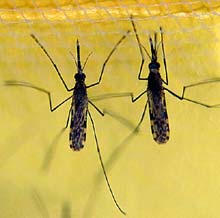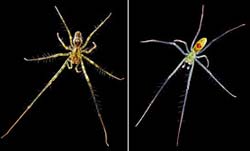Life Sciences and Chemistry
Articles and reports from the Life Sciences and chemistry area deal with applied and basic research into modern biology, chemistry and human medicine.
Valuable information can be found on a range of life sciences fields including bacteriology, biochemistry, bionics, bioinformatics, biophysics, biotechnology, genetics, geobotany, human biology, marine biology, microbiology, molecular biology, cellular biology, zoology, bioinorganic chemistry, microchemistry and environmental chemistry.

Progress in probing the mosquito’s sense of smell
Researchers find odorant in human sweat that attracts female mosquitoes
Today, we know a little bit more about one of mankind’s deadliest enemies, the mosquito. Scientists have taken an important step toward understanding the mosquito’s sense of smell, an avenue of research that may lead to better ways to repel the deadly insect.
In a joint effort reported in the Jan. 15 issue of the journal Nature, researchers at Vanderbilt and Yale universities have verified that

Chemists learn to build curved structures with nanoscale building blocks
The natural world is full of curves and three dimensions, but the ability to deliberately and rationally construct such complex structures using nanoscale building blocks has eluded nanotechnologists who are eager to add curved structures to their toolbox.
Now a team of Northwestern University chemists report they have discovered ways to construct nanoscale building blocks that assemble into flat or curved structures with a high level of predictability, depending on the architecture and com

New study finds evolutionary diversification in Hawaiian spiders
About 5 million years ago, the first spiny-legged Tetragnatha spider landed on what is now known as the Hawaiian Islands, with subsequent generations evolving into different species to fill in specific niches in various habitats. Now, these spiders provide evidence for nature’s propensity for generating diversity in a systematic way.
In a new paper published in the Jan. 16 issue of Science, University of California, Berkeley, biologist Rosemary Gillespie uses genetic detective work to descr

Transgenic Mosquitoes are Less Fertile Than Their Counterparts in Nature
Discovery, Published in the Proceedings of the National Academy of Sciences, Flies in the Face of Past Assumptions
A UC Riverside team in the Entomology Department has found that genetically engineered mosquitoes are less fertile and less healthy than mosquitoes that have not been altered.
The discovery, made in the laboratory of biological control extension specialist Mark Hoddle, has been included in the latest issue of the journal Proceedings of the National Academy of S

Fossilised Embryos – 500 Million Years Old
Evidence from fossilised embryos of worm-like creatures that lived 500 million years ago shows that embryos developed then in much the same way as their living relatives do today. The implications of this remarkable discovery, reported in this week’s issue of Nature, is that embryological processes that occur today must have been established very early on in the evolution of animals.
Because embryos are composed of tissues that decay away to nothing in an instant they are very rarely preserv

Mars on Earth?
Researchers from LSU, NASA and Mexico find Mars-like conditions in a South American desert
A team of scientists from LSU, NASA, the Universidad Nacional Autonoma de Mexico and other research organizations has discovered an area of Earth that is shockingly similar to the surface of Mars.
This joint research effort has discovered clues from one of Earth’s driest deserts about the limits of life on this planet, and why past missions to Mars may have failed to detect life.